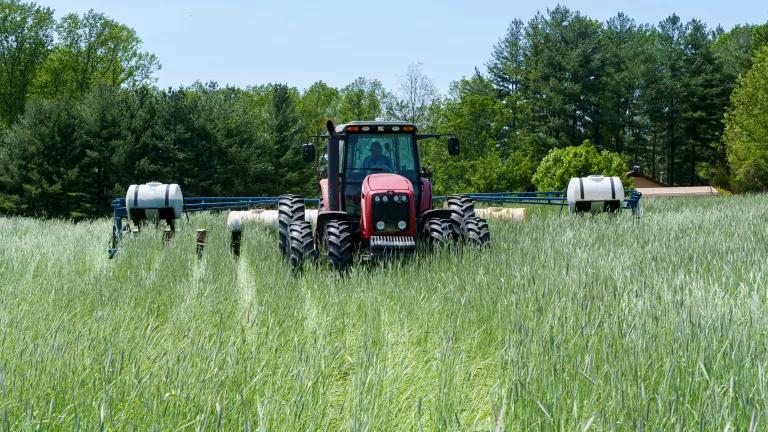
Per Capita Emissions Dropped, Driven by a 19% Decrease in Beef Consumption
Finally, some good news on climate change: Whether they know it or not, Americans have been fighting it with their forks.
A new report—Less Beef, Less Carbon—released today by NRDC shows that between 2005 and 2014, we reduced our per capita consumption of beef by 19 percent. This resulted in pollution reductions equivalent to removing tailpipe emissions of 39 million cars from the road. It also drove an overall 10 percent decrease in per capita emissions from the U.S. diet.
Even more notably, because we ate much less beef, the overall emissions from our diet went down by 3 percent, despite a 9 percent increase in the U.S. population during this time.
In the fight against climate change we often overlook the impact of the food we eat. Yet, according to the United Nations, producing the livestock we eat generates as much climate pollution each year as all the tailpipe emissions from all the vehicles in the world.
Red meat—from cows, sheep, goats and pigs—is a leading source of this pollution. The emissions are produced when we use energy to grow feed for the animals to eat, clear forests that could absorb climate pollution to make way for pastureland, and generate methane through the digestive processes of the animals themselves.
In contrast, producing most fruits, vegetables and legumes doesn’t generate anywhere near as much pollution. In fact, beef is about 34 times more climate pollution-intensive as beans and lentils, pound for pound.
As a result, the decrease in beef consumption documented in Less Beef, Less Carbon, has propelled a significant decrease in the per capita climate pollution emissions from our diet.
The decrease in the consumption of beef documented in the report has, in large part, been a welcome side effect of growing concerns around the health impacts of eating too much red meat. In recent years, numerous public health organizations—from the American Heart Association to the World Health Organization to the Harvard School of Public Health have been recommending substituting healthier options for red meat. They cite an increased risk of cancer, heart disease, diabetes and premature death as reasons to cut our consumption. We can add the health of the planet to that list.
The marketplace is taking note. The restaurant industry has reported a decreasing preference for red meat in their menus. The James Beard Foundation, a leading industry collaborative said that one of the top food trend forecasts for 2017 is likely to be "“seeing beef move from the star of a menu to more of a supporting player.” The National Restaurant Association’s 2016 ‘What's Hot Survey' also stated that “nearly 60% of professional chefs listed meatless items among the top culinary trends.”
But while Americans reduced beef consumption in recent years, we still eat much more than health experts recommend and much more than most countries in the world. We rank fourth globally in per capita beef consumption, eating more than twice as much red meat as suggested by USDA’s recommended dietary patterns. This overconsumption also continues to have serious consequences for our planet. Our analysis shows that beef consumption accounted for 34 percent of the emissions from the U.S. diet in 2014, the single largest source by far of any food. A continued reduction of red meat consumption in our diet will bring even more benefits to our environment and health.

Beef accounted for 34% of all diet-related emissions in 2014 (more than any other food by far)
What does this mean for my dinner?
Not ready to give up meat entirely? The great news is that even small changes can make a big difference for health and the planet. Our analysis shows that if Americans cut just one quarter-pound of beef a week, it would be like taking 10 million cars off the road for one year. A great way to do this is to eat “plant forward.” Plant-forward meals can still include meat, even red meat. With plants front-and-center red meat can be a flavor-enhancer, condiment or a side dish. Other strategies for plant-forward eating involve innovative dishes like ‘blended burgers’ that mix mushrooms or other plants into beef patties to decrease the volume of beef served, or reducing the portion sizes of red meat dishes. These dishes can look like this:


Institutions can also play a role in promoting public health and a diet that is healthier for the planet. The three largest food service companies in the U.S. operate tens of thousands of sites each day and are the second, third and fourth sellers of meals domestically. Together, these three companies purchase approximately 183 million pounds of red meat annually. Food service providers and venue managers can play a powerful role in encouraging healthier diets by shifting away from red meat-heavy menus and offering the plant-forward, globally-inspired foods that consumers, particularly millennials, crave.
Furthermore, changes to beef industry management practices could reduce the lifecycle climate change pollution impacts of beef. Most beef cattle in the United States today are finished on grain in industrial feedlots, often known as concentrated animal feeding operations (CAFOs). Growing this cattle feed (primarily corn and soy) requires large amounts of pesticides and fertilizers that, in turn, require significant inputs of fossil fuels. Alternative models of beef production, such as intensive rotational cattle grazing, can help sequester carbon in the soil and provide numerous other health and environmental benefits compared to CAFOs. Better storage and disposal of manure can also reduce methane emissions. What’s more, eating less red meat could free up resources to eat this ‘better meat’ that is often sold at higher prices.
Eating less red meat will have significant impacts for our health and environment. Less Beef, Less Carbon shows that we have already taken strong steps in this direction. We look forward to working with the restaurant industry, food service sector and the American consumer to continue this trend of saving the planet with our plates.




